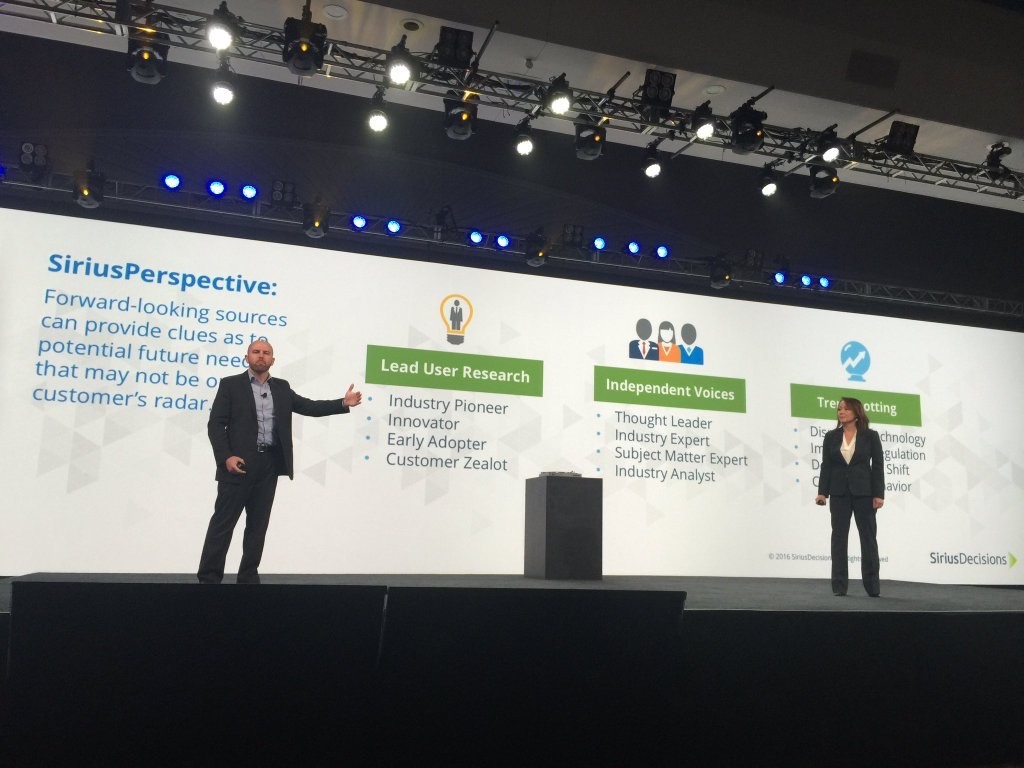You can always rely on the SiriusDecisions team to concoct complex models and conjure up in-depth insights that make you completely rethink how you create content and engage your buyers.
And deliver they did during the annual #SDSummit in Nashville, Tenn. During the show, the SiriusDecisions group unveiled more than 30 new models that spanned demand generation, content strategy, marketing strategy and sales enablement.
Sure, it’s been a little more than a week since the show ended. But within that time, I’ve mined my notes and brainstormed some tactical tips and takeaways to share with you!
The three models that really struck me were the Messaging Nautilus Version 2.0, the Needs Aperture and the Content Measurement Framework. Here are some takeaways and implications for each:
Focus Less on Preferences and More on Behaviors
Because Content4Demand uses the Messaging Nautilus in our content creation process, I was extremely curious about what SiriusDecisions changed about it and why. The Nautilus still has eight arcs and the same steps: Audience Isolation, Intent, Value Proposition and Narrative, among others. However, the most significant change is within the Persona Context arc. This is when we capture and synthesize buyer insights and try to better understand their challenges, initiatives and how they find information.
Typically, we would look at content preferences to understand the formats that target buyers gravitate to. But as Marisa Kopec noted during her presentation, this information only points to what buyers say they want, not their actual behaviors. As a result, SiriusDecisions switched “content preferences” with “asset and interaction types,” which are observable behaviors. Implement tools that empower you to understand site behaviors, search behaviors, email interactions, content downloads and even their engagement with specific assets. This is actual, hard data; it’s far more dependable than what buyers say they want. Although it’s valuable to look at content preferences and include them in your buyer profiles and personas, you should use real data to validate and make final decisions.
Think Beyond Obvious Needs
As marketers, we sometimes focus on the very obvious and direct needs of our buyers. We may think that we’re simply “creating buyer-focused content,” and to an extent, that’s true. At the same time, though, we’re also missing out on a much larger picture and set of needs that may allow us to differentiate in our market and perhaps even engage a completely new audience. Enter the Needs Aperture. Similar to a camera, the Needs Aperture has many settings that allow you to expand your view of buyers and their needs. The five phases include: Frame, Focus, Find, Filter and Formulate.
Of course, the foundation of a successful campaign is understanding your buyers’ needs, or a “desired outcome that has business value to a persona.” It’s about knowing the who, what and why. (If you studied journalism like I did, this is probably engrained in your brain.) But there are three additional layers to consider when looking at persona needs: Organizational need, functional need and individual need. Right there, we have three different potential messaging layers.
What I found most interesting about the Needs Aperture, and what I think all marketers can apply, is the Needs Landscape. This is an extremely handy grid where, on the y axis, there are explicit needs (buyers know they exist) and implicit needs (buyers are unaware of their existence). Then there is time outlook on the x axis, which is either established or emerging. You can categorize potential needs based on these factors, and then start to identify your target audience, start to understand their true needs, prioritize them and then apply them across marketing, sales and product departments.
Balance the Scale Between Process and Performance
How many times have you been asked to calculate and report on the impact and value of a content asset or campaign? You end up begging your team members for data and spending hours upon hours building an in-depth report or PowerPoint presentation to validate your investments.
But if you find yourself looking at standard KPIs, such as email opens and clicks, content downloads or even MQLs generated, you may not be getting the full ROI picture.
Ross Graber, Sr. Research Director at SiriusDecisions, confirmed that solving the “Content ROI Conundrum” is an ongoing issue in the B2B world. He noted that although 83% of B2B firms plan to increase their content investments, 0% fully understand the return. The key problem is that B2B firms are focusing on measuring performance and not the process by which content is created.
What falls under the process umbrella? Everything from the time, money and the manpower it takes to establish your messaging, conceptualize and build the content, and deliver the content to key audiences across different channels. When content is actually activated, you must evaluate both short- and long-term business impacts, including: Consumption (usage by delivery path), Outcome (progress along the target journey) and Impact (business value against objectives).
Of course, I’ve oversimplified the Content Measurement Framework for the sake of this blog, but Graber’s presentation reaffirmed one thing: B2B firms need to think bigger in terms of their goals and how they can track and measure results. We need to shift some attention away from the bottom-line impact and focus more on what’s happening inside the organization. We need to think about how many team members we have to strategize and create content, how much time it takes, the volume of assets we can create, the cost and, most of all, our efficiency.
Considering all these factors, we need to establish a broader set of goals for our marketing team. Only then can we show, in a more detailed way, just how valuable our content is.






